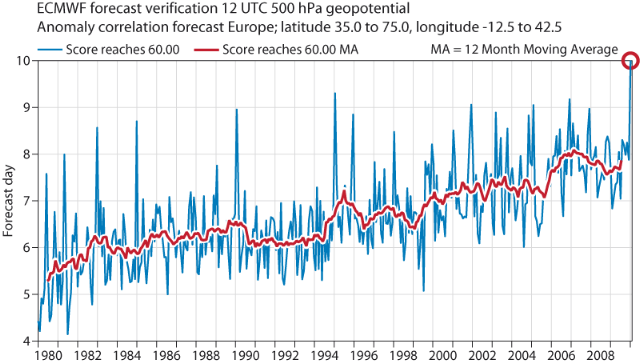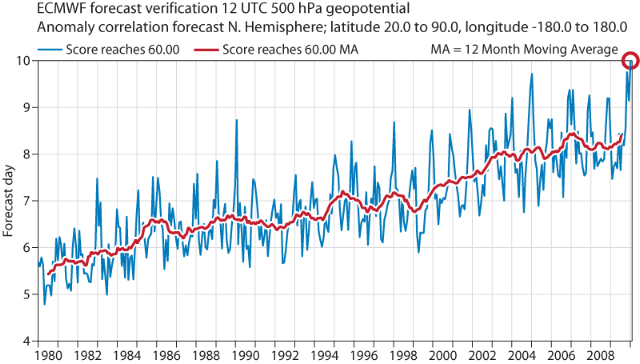

In February 2010, ECMWF reached a landmark in the performance of its deterministic forecasting system. For the first time ever, the headline measure of skill reached the forecast range of 10 days.
ECMWF carries out comprehensive verification of its forecasting system. An overall measure of the quality of the medium-range forecasts in predicting the large scale weather systems is given by the anomaly correlation coefficient (ACC) of 500 hPa height forecast field. A key performance indicator for the forecast system is the forecast range at which the ACC drops to 60%. In the early 1980s this level was reached at around forecast day 5. Continuous improvements to the forecast and data assimilation systems have resulted in steady improvement at around one day per decade so that on average the 60% level is now reached at around day 8. In February 2010 the average monthly ACC remained above 60% throughout the 10-day range of the deterministic forecast for both the European region and the northern hemisphere: 67% at day 10 for the northern hemisphere and 61% for Europe.


Monthly mean (blue) and 12-month running mean (red) of the forecast range at which the anomaly correlation for 500 hPa height operational forecasts falls below 60% for Europe (upper panel) and the extra-tropical northern hemisphere (lower panel). The final point on each curve (circled) is for February 2010 and is marked at forecast day 10. The actual score for February would be higher, but the forecast is not run beyond 10 days: the average February anomaly correlation at day 10 was 61% for Europe, 67% for the northern hemisphere.
As the long-term performance record shows, there is substantial month-to-month fluctuation in the scores due partly to the variability in the atmospheric conditions. This is more prominent over smaller regions such as Europe. Winter 2009-10 has been unusual over the northern hemisphere with a strong negative phase of the North Atlantic Oscillation and Arctic Oscillation patterns. These typically are associated with cold weather in northern Europe and more active weather systems affecting south west Europe. The high scores for the ECMWF model confirm that it has performed consistently well in predicting these anomalous weather conditions.
There have been a number of severe weather events during February. Notable over Europe were the severe winter storm Xynthia, one of the most damaging storms of the last decade, which affected much of Western Europe on 26-28 February, and a number of storms that affected south-western regions including the devastating floods in Madeira on 20 February. Prolonged cold weather and large snow accumulations affected large parts of Scandinavia and Finland. The U.K and more recently Spain and southern France have also experienced disruption due to snow. ECMWF forecast from both the deterministic model and the ensemble prediction system provided consistent early warnings for these events.
A selection of ECMWF verification results is available on the following ECMWF web site:
http://www.ecmwf.int/products/forecasts/d/charts/medium/verification/
The annual report of the performance of all the ECMWF forecast systems which includes comprehensive verification of all aspects of the models’ performance is available as ECMWF Tech. Mem. No. 606, available from the ECMWF web site:
http://www.ecmwf.int/publications/library/do/references/list/14
